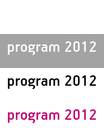| poprzedni | lista |
|
Gazeta Festiwalowa "Na horyzoncie", nr 10
27 lipca 2012
On The Town
Ian Haydn Smith Editor, International Film Guide Leos Carax's ‘Holy Motors’ was apparently inspired by the filmmaker's fascination with stretch limousines and their life after hours. From this curious standpoint he has created a magnificent, absurdist vision of the world. Theories on exactly what the film is about have become legion since its premiere at Cannes. The luxury executive car may have been the starting point for ‘Holy Motors’ (and also its end, as evinced by the film's hilarious coda). But what happens in between is the product of a wild and vivid imagination. The plot, or what there is of it, involves one man, played with gusto by Denis Lavant, who transforms himself within a spacious limo into 11 different characters. They range from a businessman and beggar to a father, gangster and somewhat unconventional family man. Driving the car is Céline, a mostly impassive chauffeuse. In addition to ensuring his timeliness with each appointment, she is a prop for his flagging spirit. There is no clear link between the various episodes, beyond the central character being played by Lavant. (The 'Merde' character, who roams a Parisian cemetery, has previously appeared on screen before, in Carax's entry for the 2008 portmanteau film 'Tokyo!') There is one moment, when two limousines almost collide, where it is implied that we have discovered the real man behind the façades, encountering a woman he once had a relationship with. But like all the other characters, it is merely a fabrication. However, this begs the question, is the film ultimately a treatise on the fantasy of cinema and how the fables it constructs have come to dominate the fabric of our lives? We open with Carax himself breaking into a cinema, which then transforms into the world we will travel through. The interior of the car resembles an actor's changing room, with the outside world one large film set. Unlike the ascetic, sci-fi interior of the limo in David Cronenberg's ‘Cosmopolis’, which also played at Cannes this year and where any commonality between the two films ends, Carax's auto-fantasy is ordered chaos. It is actually Cronenberg's earlier film ‘Videodrome’ (1983), which also blurs the line between the real and the fantasy, that ‘Holy Motors’ most closely resembles. Both attract our curiosity and are successful in the way they create an alternate reality, one that is similar to ours, but with certain crucial alterations. Kylie Minogue, playing the passenger in the other limo, feeds into this alternate reality. Carax cleverly plays with her persona and the singer gives him her most convincing performance. In a set-up for a passionate embrace between the reunited couple, we are instead treated to a brilliant parody of musical genre conventions. Carax does the same with Edith Scob's driver. In her final scene he has Scob don the mask she wore throughout Georges Franju's 1960 horror masterpiece 'Les yeux sans visage'. There is no longer reality. There is just the movies. No matter what it is about, ‘Holy Motors’ is one of the most entertaining and original films for some time. It could be making a serious statement about the way we regard cinema. At the same time, all the theories regarding what it means could solely be the figment of the viewers imagination. It may just be that Carax is taking the piss. Either way, it is the best ride in town. |
Moje NH
Strona archiwalna 12. edycji (2012 rok)
Przejdź do strony aktualnej edycji festiwalu:
www.nowehoryzonty.pl Nawigator
Lipiec 2012
Szukaj
filmu / reżysera / koncertu
|



















